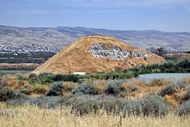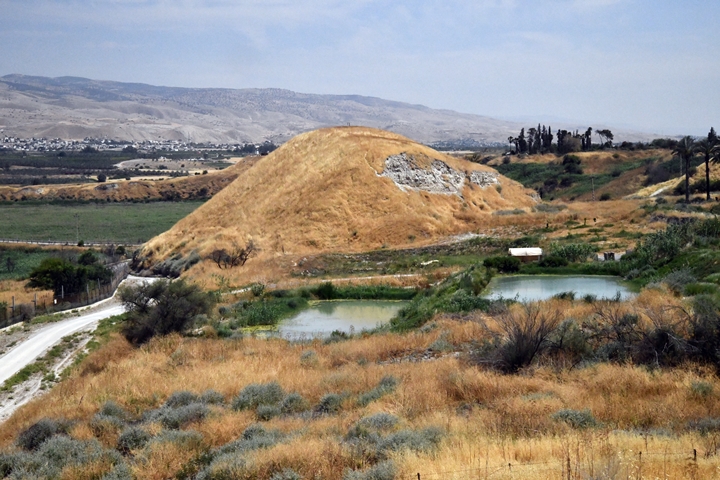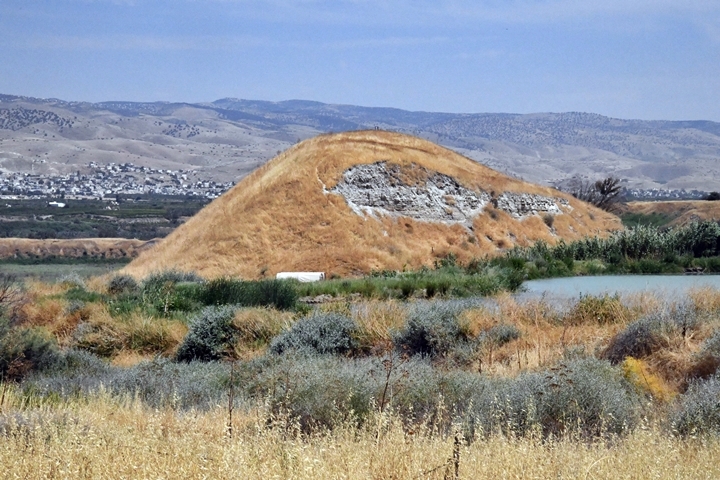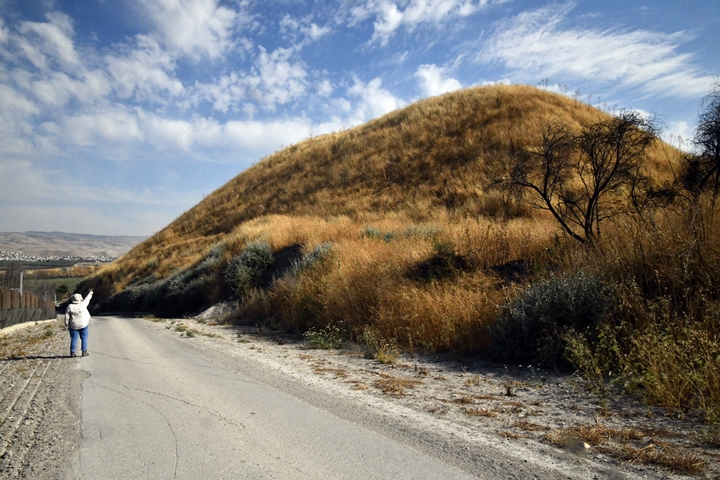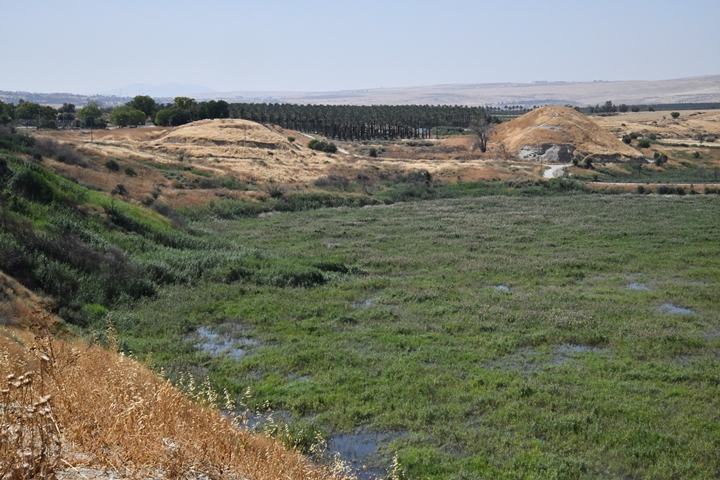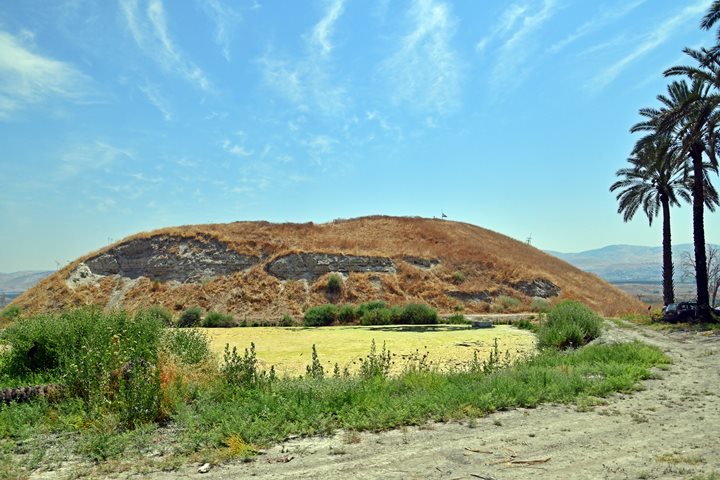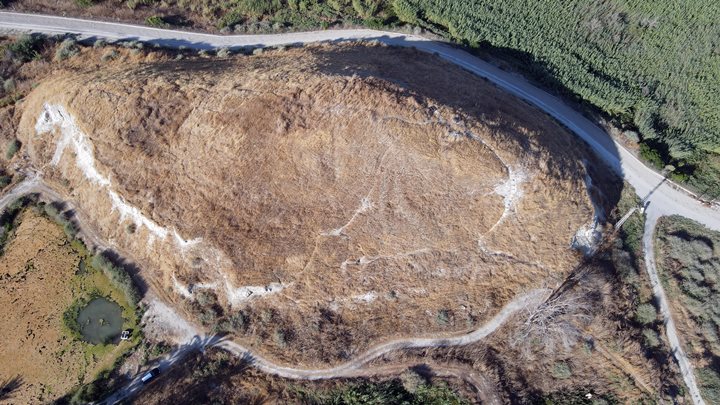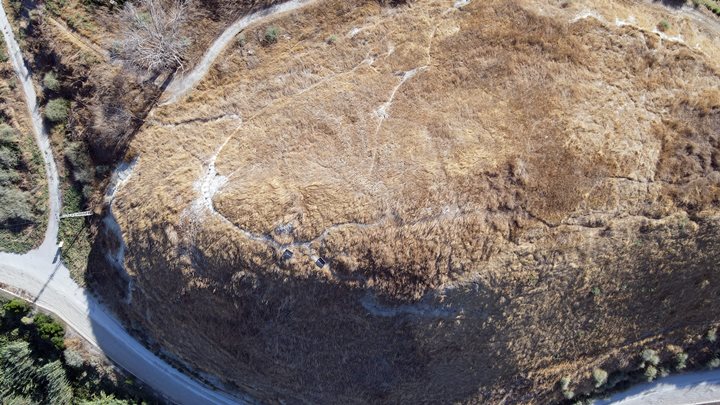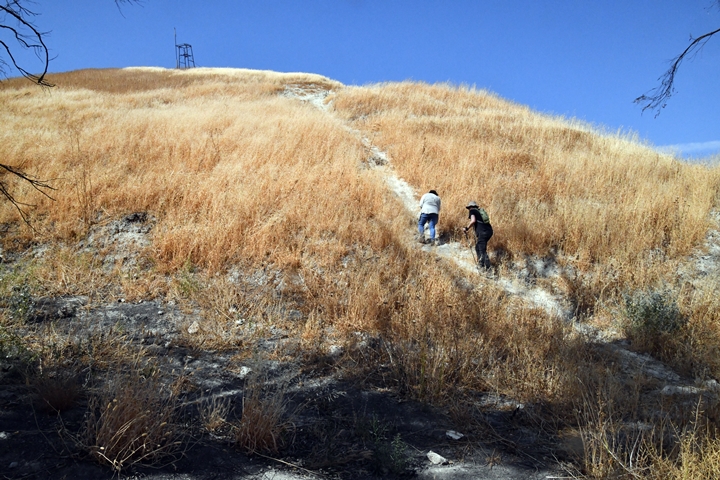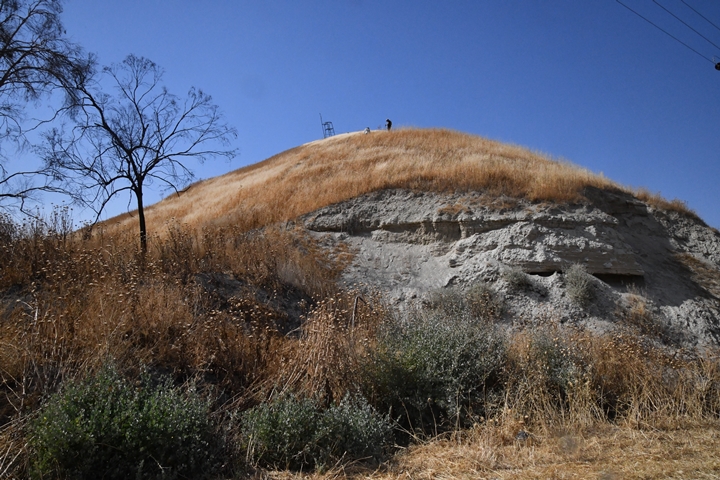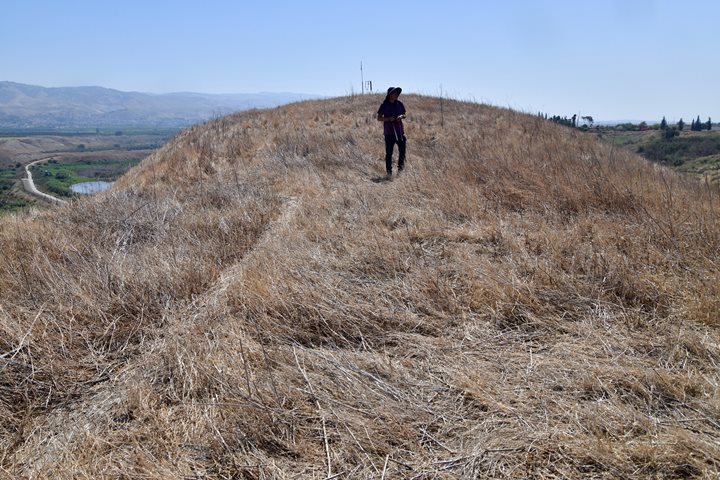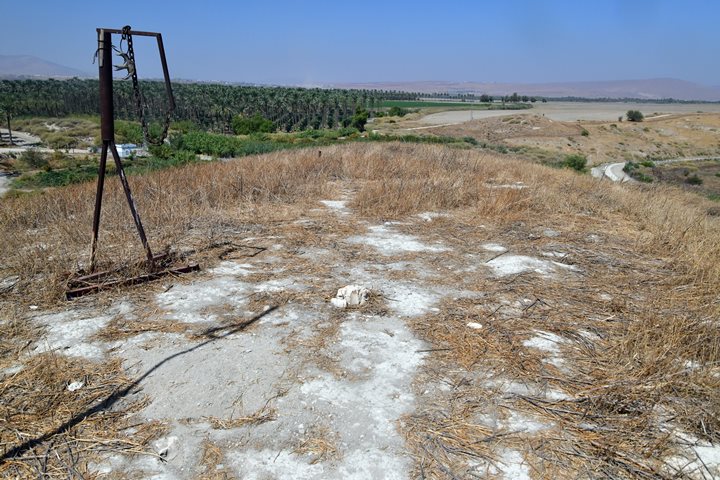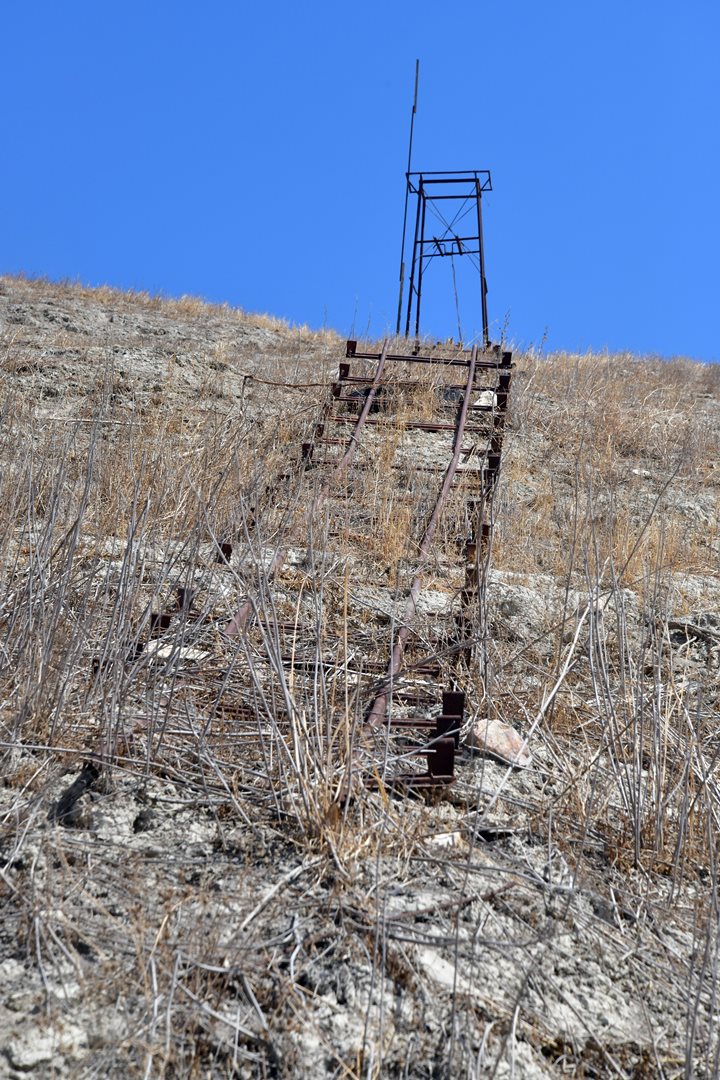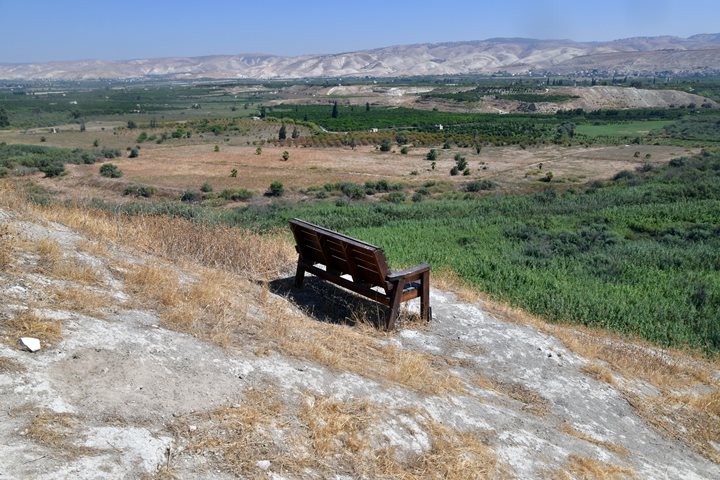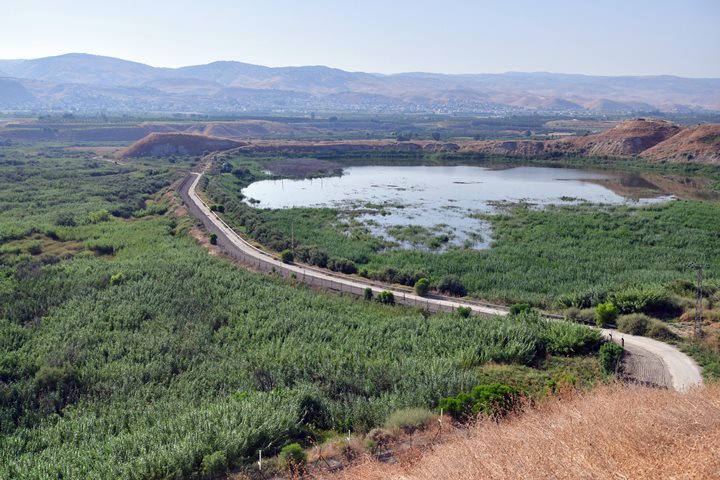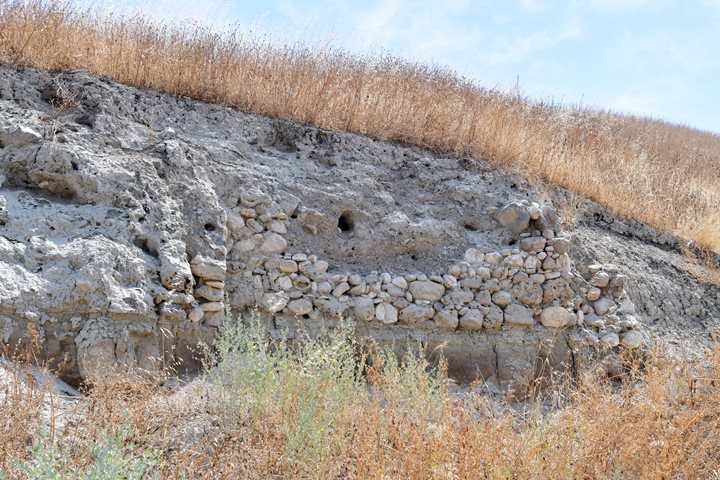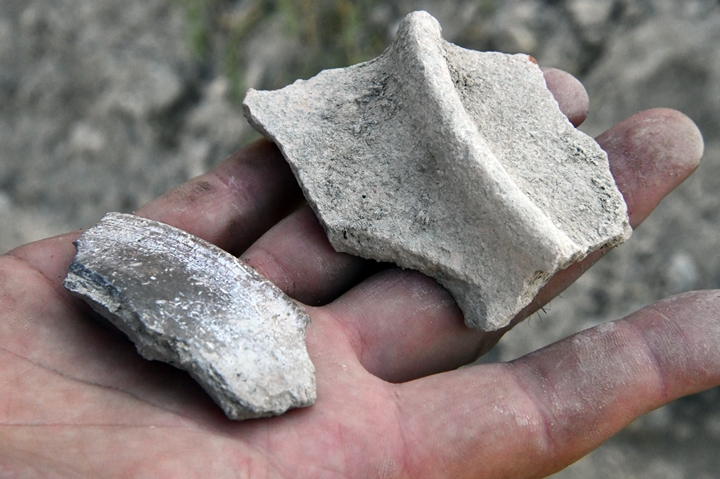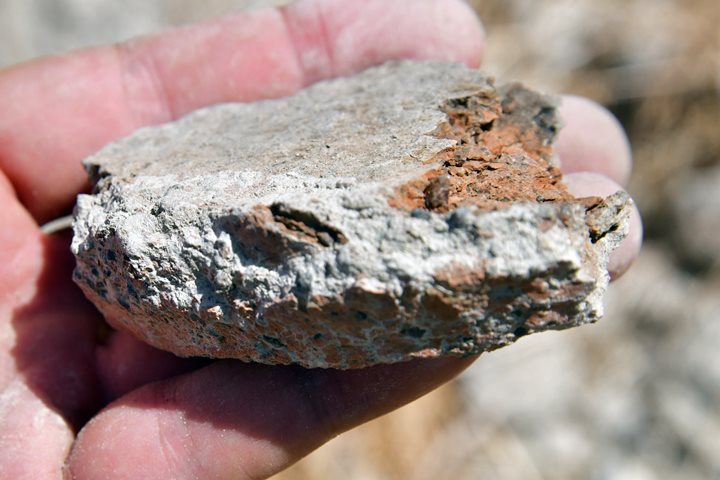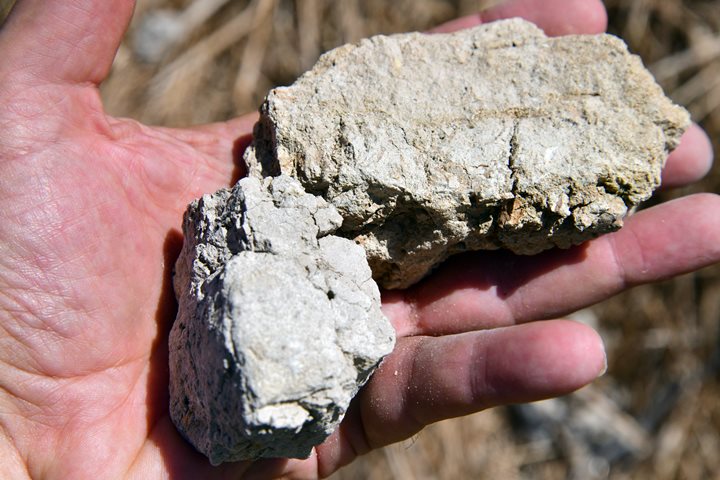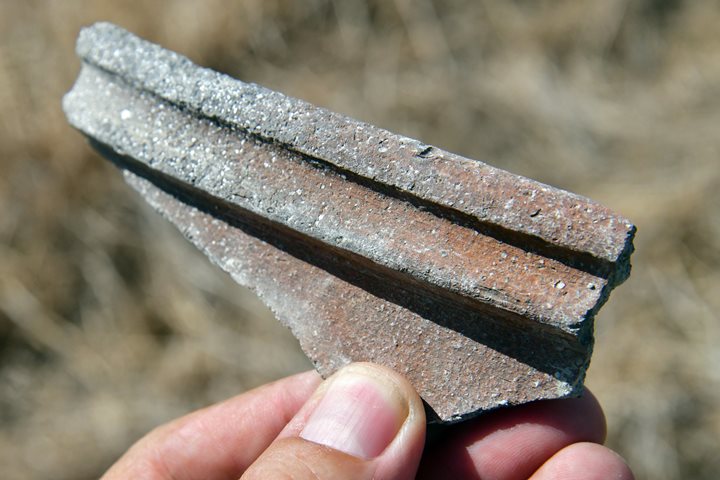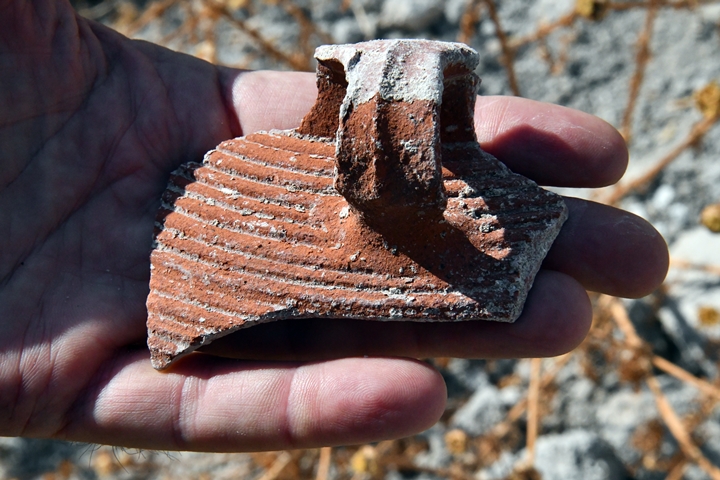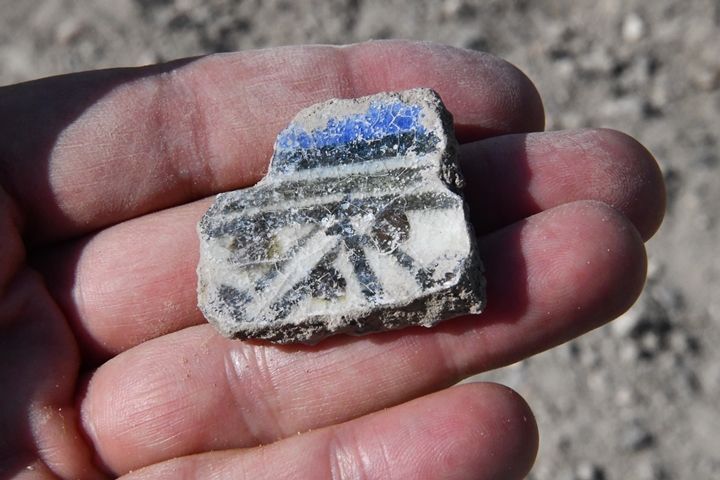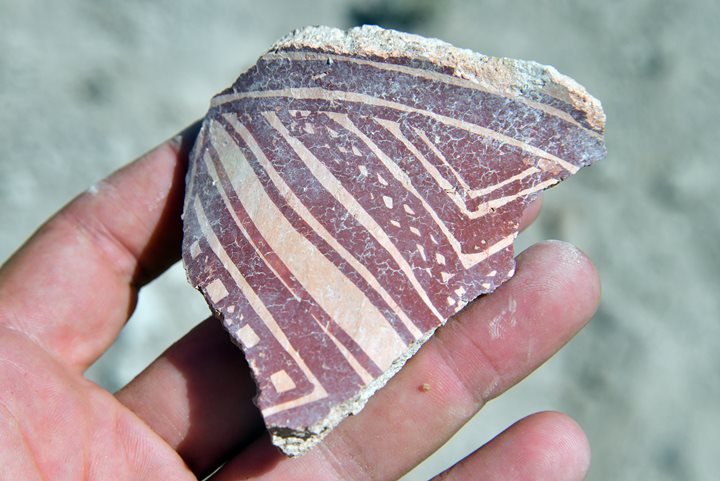An artificial mound located in the central Jordan valley, that guarded a major crossing point of the Jordan river.
Home > Sites > Jordan Valley > Ruppin sites > Tel ‘Artal (T. esh-Sheikh Daoud)
Contents:
Background
Location
History
Photos
* North view
* North East
* East view
* West view
* Summit
* Southern Foothills
* Findings
* Survey Video
Etymology
Links
Background:
Tel ‘Artal (Tell esh-Sheikh Daoud) is an artificial mound near Kibbutz Kfar Ruppin, in the Central Jordan valley region. It overlooks the Jordan river and controls a major crossing point known as Makhadet esh Sheikh Daoud (Ford of Sheikh David).
(Joshua 2:7): “And the men pursued after them the way to Jordan unto the fords…”.
Location:
The site is located 0.5km north of Kibbutz Kfar Ruppin and 3.5km south of Kibbutz Maoz Haim. The hill rises above the Jordan river that flows near its eastern foothills. It is located south of streams Nahal Hobari and Nahal Masil el-Jizl. This steep mound has a narrow summit, with an area of 100m by 25m. Its height is 241m under sea level, about 34m above the river bank.
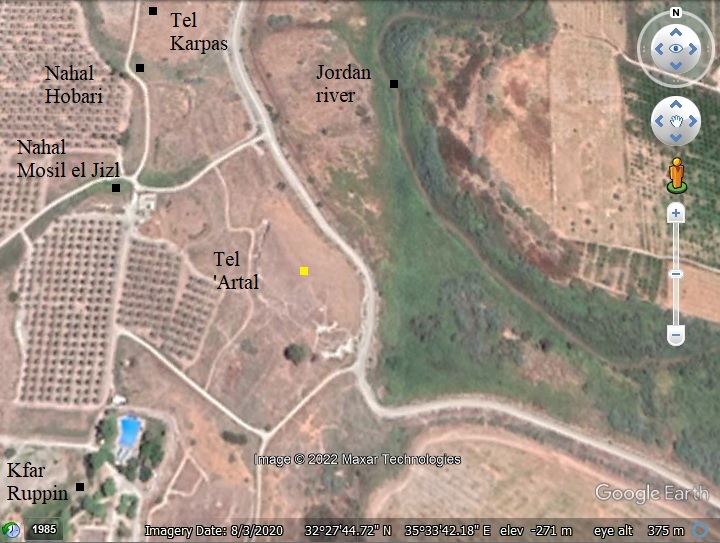
History:
Tel Artal is a multi-period archaeological site.
Flintstones collected here were dated to the Upper Paleolithic and Chalcolithic period.
Ceramics collected on the mound and on its foothills were dated to the Early Bronze (many), Intermediate Bronze, Mid Bronze II, Late Bronze (many), Iron I, Iron II (many), Persian, Hellenistic, Roman, Byzantine, Early Muslim, and Mameluke.
-
Biblical map
The cities and roads during the Canaanite and Israelite periods are indicated on the Biblical Map below, with Tel Artal marked by a red dot on the west bank of the Jordan river.
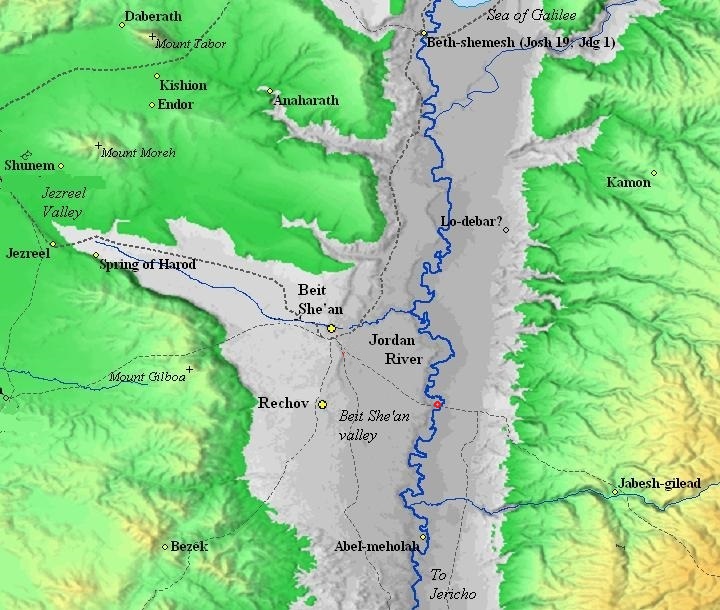
Map of the area around Tel Artal – during the Canaanite and Israelite periods (based on Bible Mapper 3.0)
David Dorsey (“The roads and Highways of Ancient Israel”, 2018, pp.111-112) suggested that a east going highway (marked T7c), connecting Jezreel and Beit She’an thru the fords near Tel Artal, was the major route used to cross the Jordan river. This route is marked in the map as a dashed line that crosses the Jordan river, passing near the red dot. The main river crossing was named Makhadet esh Sheikh Daud (ford of Sheikh David). It is near the Bronze/Iron age sites of Tel Artal, Tel Karpas, Tell el Qitaf, Tel Masad and Tel Rehese in Kefar Ruppin. The highway connected on the other side of the Jordan river to the city of Pehel (Pella), and was the main crossing point in this region. It continued to the Transjordan highlands and on to Damascus and beyond.
- Roman period
An ancient Roman highway (from Scythopolis/BethShean to Pella/Pehel) passed on the north side of Tel Artal. It probably traced the route of Nahal Hobari that flows between Tels Karpas and ‘Artal.
A group of 5 Roman milestones were found during the PEF SWP survey in Umm el-‘Amdan (K. Ruppin map 67, site 86). The PEF survey wrote about this find (Vol 2 p. 130): “Several fragments of rude pillars, lying in the water by the road. They seem probably to be Roman milestones”. Their location was 1.5km NE of Tel ‘Artal, and 5.8km from Scythopolis, on the north bank of Nahal Hobari. Two of the milestones marked the 4th mile from Scythopolis to Pella, which is the distance where they were found (5.8km = 4 Roman miles). The group of milestones were transferred to Gadash Gilad shed.
-
Later periods
The site was examined in the PEF survey (1866-1877) by Wilson, Conder and Kitchener. The surveyors assumed it was a natural hill. They also ignored the other Tels around it. Their survey report was short (Vol 2, p. 128):
“Tell esh Sheikh Daud—Possibly a natural mound; a ruined Mukam of modern masonry exists near it”.
A section of their map is shown here. Notice the serpentine shape of the river at this point.
The river crossing (marked as Mak.t – short for Makhadet – Arabic for ‘ford’) appears as a line south east of the Tel. The map shows a large number of fords that were used for the river crossing, also marked as Mak.t. A road, leading to the river crossing, appears at the south side of the hill. This may have been the route of the Roman period road and during the previous periods.
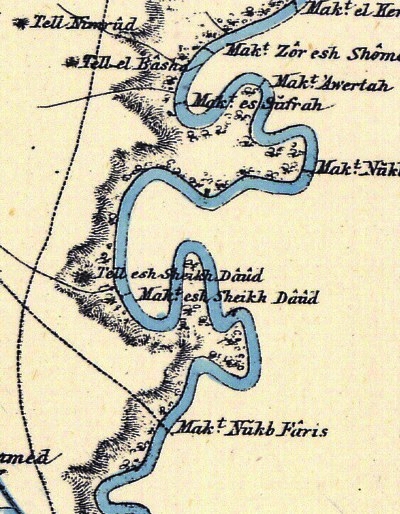 Part of Map sheet 9 of Survey of Western Palestine,
Part of Map sheet 9 of Survey of Western Palestine,
by Conder and Kitchener, 1872-1877.
(Published 1880, reprinted by LifeintheHolyLand.com)
- British Mandate
A 1940s British map shows the area around the site with more details. The site is marked here as “Tell esh Sh. Daoud”. The Jordan river passes on its eastern side. Its course changed a bit (moved slightly east) as marked by the purple colored parallel lines that were drawn as corrections.
A number of other Tels (6) are marked around it. The number of ancient sites in this small area indicate the importance of the area during the antiquity. This is one of the most highly concentrated areas with Bronze/Iron Age ruins.
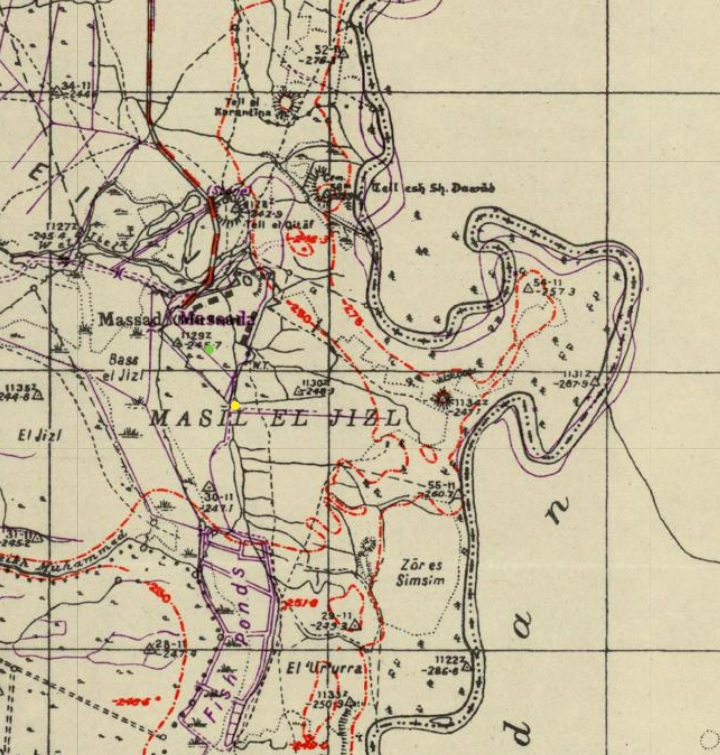
British survey map 1942-1948 – https://palopenmaps.org topo maps
License: public domain under the UK Copyright, Designs and Patent Act 1998
A 1922 archaeological survey reported:
“Tell Esh Sheikh Daoud – Only one tell is marked on the map and that not the most important. Actually there are not less than six grouped together, the largest lying to the South of that marked on the map and having on the top several Moslem graves. Right on the summit is a trigonmetrical station for the new survey, which is marked by a beacon. The other four tells lie to the West and South of this and one of them has an occupied Arab house upon it. This settlement was evidently one of great importance” Visited 27.5.1922″.
The surveyors added:
“Due East of Sheikh Daoud a tongue of high ground runs North into a Loop of the Jordan, On this are two tells one on the tip and the other at the root. Little pottery was seen on the former and its possibly natural. Neither is marked on the map. Visited 27.5.1922”.
Note that we wrote these lines exactly 100 years later on 27.5.2022!
In 1938 a Kibbutz, Kfar Ruppin, was founded on nearby Tel Massad.
In May 1939 the British army requested to build a pillbox fort on the hill, but the archaeological inspector denied this request unless it was approved by the director of Antiquities. It was not…
A survey in 1942 mentioned that there are some graves on the top.
A later survey in 1946 provided additional details:
“A high artificial mound, moderate size. It is prolonged in shape running parallel to Jordan river (N-S). Potsherds of Bronze Age and later on … on surface. The Jordan river to E is fordable in two places. It lies nearly half was between Scythopolis and Pella (Tabaqat Fahl). It is most probable that the Roman road passed nearby. To the W. there is a flat mound, artificial appearance, called Tell el Qatif. Another small mound is standing to N.W… Condition: the site has not been cultivated. – RWH 9.1.46.”
-
Modern Times
Tel Artal is accessible by car from Kfar Ruppin. However, a section of the road is not permitted for entrance since it is on the Jordanian border. The restricted section is marked by signs.
Photos:
(a) North View of the Mound
Tel Artal is seen in the following view from the north side. This steep hill rises above the area, surrounded by water from three sides – Jordan river on the east side and streams Masil el- Jizl and Hobari on the north and south sides. The stream on the north was converted to fish ponds.
Click on the photos to view in higher resolution…
A closer view of the hill from the north side is in the following photo. Behind, in the background, are the Jordanian mountains (Gilead) and the Jordanian villages across the border. Ancient Pella is 3km away, behind the village seen here in the background.
(b) North east view of the mound
The road cuts on the eastern side of the Tel’s foothills. Archaeologist Ayelet Goldberg-Keidar, who led the short survey of the site, points to the northern edge of the summit. This side of the mound is too steep to climb up.
(c) East view of the mound
The Jordan river loops around, flowing from the side of Tel Artal towards the east. A small lake formed inside the loop.
Tel Artal is seen here in the right background. On the left background is another multi-period Tel – Horvat Daveka (IAA survey site #79).
This views is from another Tel – named Horvat Zarom (IAA survey site #76). It is a small hill, 2 dunams in area, with ceramics dated to Early Bronze 1, Middle Bronze 2, Late Bronze, Iron 1 and 2 and Byzantine periods.
(d) West View of the mound
Below – a view of Tel Artal from the west side. Earthworks, conducted by the Kibbutz during the 1970s, damaged this side of the mound.
The dirt road on the right is a convenient path to the ascent on the south side.
(e) Summit
An aerial view was captured in 2024 above the site (credit: Ayelet Goldberg-Keidar). The view is oriented towards the east, with the edge of the Jordan river seen on the top right side. The summit spans 100 meters by 25 meters, is 34m above the river, and is mostly bare.
Another view is oriented towards the east. Notice the stepped trail ascending on the south (left) side.
A stepped trail leads up to the top of the hill from the south side. This is a steep and dangerous trail. The wooden steps along the trail are occasionally repaired, but the soft soil does not hold them too long. Don’t climb up without walking sticks and watch your steps.
On the summit was a Muslim graveyard, including a shrine of Sheikh Daoud.
There are no visible ancient structures on the top. Future archaeological excavations, yet unplanned, could unearth the ancient layers of the ancient cities buried under the ground.
A small modern metal sculpture is seen on the southern side of the summit. It consists of a metal chain and a bird.
In the late 1980s Danny Zayit, a sculpture from Kfar Ruppin, built an environment monument with the help of Jews and Arab youths. The environment monument was constructed with local stones that were laid across the southern foothills, in order to symbolize peace between Jews and Arabs. His art work consisted of a form of a giant arrow made of stones. The ‘arrow’, expressing hope, pointed to the sky and towards the east. This monument gave Tel Artal its nickname – the “hill of Peace”.
The stones were pulled up the hill with a pully and a rail track.
From the summit are great views of the Jordan river and the Jordanian mountains. This view is towards the north east.
Next is another view towards the east. Two other ancient mounds are seen here – Halashon and Horvat Zarom. In the far background, on the foothills across the Jordan valley, is the major city of Pehel (Pella).
According to the PEF map, the river crossing was located thru the bush area on this south-east side of Tel ‘Artal, where the river completed a full turn towards the east. However, the crossing point changed over the years as well as the course of the river.
(f) Southern foothills
A view of the southern foothills was captured during the winter from Horvat Daveka. In the green area on the south side of Tel Artal is the Habori stream.
Tel ‘Artal is cut from several sides. We decided to examine one of the cuts from a closer view – here on the south side.
Remains of a wall or the base of a structure is visible on this cut. This may have been a section of a retaining wall.
(g) Findings
Bronze and Iron age pottery are visible around and on the hill. The following are few samples of interesting findings. All items were returned to their original location.
Iron II vessel:
Bronze/Iron Mud Brick:
Bronze/Iron Mud Brick:
Bronze/Iron Mud Brick:
Iron Age vessel:
Remains of a Roman jug were also seen on the south side:
A Mameluke or Crusaders period glazed and colorful sherd were also found on the east side.
Another Islamic period colored pottery:
(h) Field Survey
![]() This 20 minutes video, filmed on February 2025, records a visit by BibleWalks team on the area around and on top of the mound, examining the ancient remains, and enjoying the lovely winter day.
This 20 minutes video, filmed on February 2025, records a visit by BibleWalks team on the area around and on top of the mound, examining the ancient remains, and enjoying the lovely winter day.
Etymology (behind the name):
- Tel (Tell) – mound (See more on the story of a Tel).
- Tel Artal (also ‘Arttal) – named after a local flower, Hebrew: עַרְטָל מִדְבָּרִי – Latin: Gymnocarpos Decanderum.
- Tell esh-Sheikh Dawud (Daoud, Daud) – Arabic name of the site, named after the (unknown) Sheikh
- Hill of peace – nickname of the hill, based on an environment monument that was built on the summit
- Makhadet – Arabic: Ford
- Makhadet esh Sheikh Daoud – Ford of Sheikh David
Links:
* External, archaeological links:
- British Mandate survey report
- IAA survey, map 67, site 82 Tel Artal site
- IAA survey, map 67, site 86 5 Roman milestones
- N. Tzori 1962, site 53 (pp 156-157)
- Hadashot Arkheologiyot 1977
- Middle Bronze I tombs at Tel ‘Artal – Orna Hess [Basor 1984]
- Crossing the Jordan river during the Biblical period – north versus south – David Moster, Aram 29 (2017), pdf
- Late Bronze Survey in Jordan valley – James Mark Schaaf (545 pages, 2012, thesis, Univ S. Africa); great resource!
- Bergman & Brandsteter Arch. surveys in Beit She’an valley (1940-1941:86-90, Hebrew)
- Survey of Tel Rechov area – Ahia Cohen-Tavor , 2010, Hebrew Univ, Hebrew
* External, other links:
- Arrow of Peace – monument by Danny Zayit on Tel Artal
- About Kfar Ruppin (bird watching)
- Biblical pictures by Gustave Doré (1832-1883) – public domain
- Wild flowers of Israel – ‘Artal flower (Hebrew)
* Internal links:
BibleWalks.com – exploring the ancient sites of Israel
Tel. Nissa<<<—previous site—<<< All Sites>>> — Next site—>>>Kfar Ruppin sites
This page was last updated on Feb 19, 2025 (add survey video)
Sponsored links:
